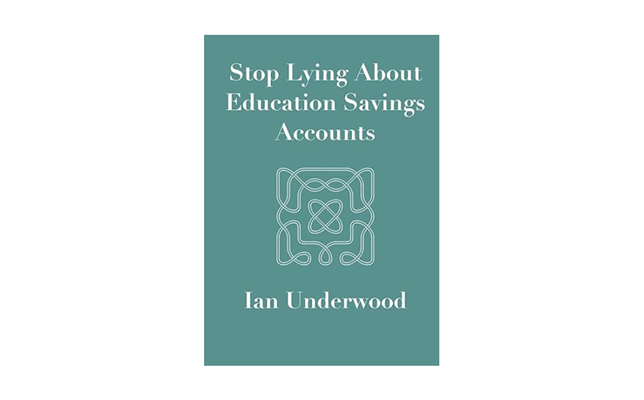When I learned that Ian Underwood’s latest book was available, I eagerly awaited an opportunity to buy it. An in-person sale that didn’t require excessive miles on my odometer. Today was the day because his wife had a table at an event in my zip code.
A few hours later, I plowed through it as it was easy to read like all the others in his collection.
But before I get into discussing the book, it’s important to share some relevant details about myself that are not included in my review of the first 3 of his books (that I read).
While nobody likes people who talk about themselves too much, think of what I will say more like a disclaimer for the sake of rigorous honesty. After all, Page 10 says it’s the author’s hope that people on both sides of the ESA controversy will be more open and honest about what their goals actually are. More on that in a moment, but my disclosure is about the relationship between my wallet and OPK (other people’s kids). I don’t have kids, I never wanted kids, and I resent being forced to pay OPK-related expenses. It’s important to get that out in the open in keeping with Page 10’s words and while reviewing talking points 1 and 2 of 4, so let’s get started.
The back cover says the following:
“I’m neither for nor against ESAs. All my libertarian friends say I’m supposed to like ESAs. But I’ve never found the arguments for them persuasive. This book is a record of my attempts to figure out exactly why.”
To me, that’s the subject of the book, and I’ll offer my own thoughts on how reading the book changed them.
There are four arguments on Page 9 that are hammered out in articulate detail over the next 124 pages. They are as follows:
1) ESAs reduce overall spending, thus saving taxpayers money.
2) ESAs can eventually provide a replacement for public schools.
3) ESAs create conditions in which free market competition will reduce costs and improve quality.
4) ESAs represent an improvement over what I call the Standard Model for helping the poor that had been developed and refined over generations.
Starting with the first argument, which I agreed with until this book debunked it, Page 7 nails it with the words “shifting” and “saving” and makes clear that they are NOT interchangeable. Many simple comparisons are made that Dr. Frank would approve of. He likes to say, “Explain it to me like I’m a kid.” This book does that. Always be cautious of the word “free” because it usually means that someone else is paying for it.
As for the second argument, I was an ardent supporter. I use the word “was” because my parade has been rained on with the author’s comparison of EFAs to UBI and some of their mutual nuts and bolts. There’s a lot of merit to the arguments, but you’ll have to read the book yourself. Personally, I’d like to see “Gov-Ed,” as Chris Salcedo calls it, totally defunded and taxes refunded(or at least reduced). For reasons noted earlier, I would get to keep what’s rightfully mine in the first place, and those who have kids could use their tax savings to fund what serves the best interest of their young. Easy-peasy. No redistribution involved and personal responsibility prevails.
Buy – Stop Lying About Education Savings Accounts
Unfortunately, what I personally want to see happen is an unrealistic goal due to a variety of reasons we all can think of. Therefore, I had always thought of the second argument for EFAs as a “starve the beast” strategy with the ultimate bonus result of vaporizing all its (what author JT Gatto called) “parasite” entities, especially the NTU. But the merits of the second argument have been called into question, so, onto the third.
There are some great Milton Friedman references poking holes into the third argument. In fact, the author renames this fantasy free market, the “freeBIE market.” One highlight is the pointing out that a free market is between TWO entities; the producer and the consumer. Once the government is involved in playing Robin Hood, you have THREE players involved. Read the book to learn more.
The fourth argument involves the public’s perception of social problems, such a poverty. Those who are poor don’t like the suffering that goes with the territory and those who are not poor don’t like the problems that go with having the poor among them, so there’s a dichotomy. Both parties agree that the problem exists, but not necessarily on the definition of “the problem” and the preferred solution. The Standard Model is explained in detail, and examples are given, such as Section 8, welfare, food stamps, etc. Then it’s explained how EFAs should be renamed “educaid,” as that’s the model being used, with all the flaws included. Again, you can learn more about the flaws in the book.
All in all, great talking points are made, and I feel enlightened, particularly by the Page 56 comment about how the (enemy camp)opponents of EFAs are wise to the “starve the beast” strategy in the second argument. I’m certainly not advocating pulling the plug on EFAs like the enemy camp is, but future bills that expand the eligibility for EFAs now give me pause. And at what point must one view the threshold as the poor subsidizing its wealthier neighbors(who can pay their own way)?
Then there’s the Trojan Horse that Ann Marie Banfield has been sounding the alarm on for quite some time: the globalist takeover of ALL forms of education that are not Gov-Ed. So that goes back to my preferred desire that Gov-Ed be defunded, and taxpayers get to keep their money. However, we still need to do something about “Claremont 2.0” before it wreaks havoc on NH’s future.

